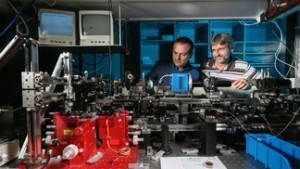Sep 9 2014
Unlike electronic circuits, optical, or "photonic", circuits work with light rather than electricity, which makes them 10 to 100 times faster. They are also more energy-efficient because they show lower heat loss, better signal-to-noise ratios and are less susceptible to interference. Used especially for communications (e.g. fiber optics), optical circuits may use tiny optical cavities as 'switches' that can block or allow the flow of light, similarly to transistors in electronics.
EPFL scientists have now fabricated and experimentally tested a silicon-based 'photonic crystal nanocavity' (PCN) that requires an unprecedentedly low amount of energy to operate as a switch. The findings, which have significant implications for the future of optical technologies, are published in a paper that features on the cover of Applied Physics Letters.
 Vincenzo Savona and Romuald Houdré ©2014 Alain Herzog/EPFL
Vincenzo Savona and Romuald Houdré ©2014 Alain Herzog/EPFL
Optical Circuits and Optical Cavities
Optical circuits control light the way an electrical circuit controls the flow of electricity. Compared to electrical circuits, optical systems show superior speed, energy-efficiency and stability. Already used in fiber optic communications, the field of applied photonics is making steady progress in developing optical circuits, which use nanoscale 'optical cavities' as switches or 'transistors' for controlling the flow of light.
Optical cavities confine light in a tiny space of a few nanometers. 'Squeezed' in such a small volume, a tiny amount of incoming light is enough to cause a small change in the wavelength of the trapped light, because of the optical properties of the material from which the cavity is made. These properties are referred to as "non-linear", meaning that if a small amount of light can make the optical cavity resonate, a higher light intensity can cause it to actually switch between two different states. This effect, called "optical bi-stability" is ultimately what makes the optical cavity to act as a switch for light.
One of the challenges in the design and development of optical circuits is their efficiency in terms of speed and energy consumption. These two features are linked together, as an optical circuit's total absorbed power depends on the energy required by a single 'switch' operation multiplied by the number of operations per second. Consequently, the most likely cavities to be implemented in an optical circuit must be designed for minimal switching energy.
A New, Low-Energy Transistor for Light
The groups of Romuald Houdré and Vincenzo Savona at EPFL have now designed, fabricated and successfully tested an optical cavity based on a 'photonic crystal nanostructure' (PCN), which requires a record-low energy to switch on and off. The PCN is made from a silicon slab, and combines a record-small size with a very high quality, or "Q", factor, which is a measurement of how long the PCN can retain light. The measured Q factor of the new PCN device is 500,000, meaning that an incoming photon will bounce back and forth inside the optical cavity five hundred thousand times before escaping.
A high Q factor means that photons spend more time inside the cavity. The new PCN also has a very small size, which produces a higher light intensity for the same energy. "The nonlinearity is proportional to the intensity and the effect is stronger if you allow for longer buildup times," explains Savona. "This is because light interacts longer with the material that provides the nonlinearity." The combination of a high Q factor with a small size is why the new PCN requires very low energy for acting as a switch.
"In this work we have achieved non-linear effects at a record-low intensity of light," says Romuald Houdré. "Our structure is also one of the smallest ever designed to show such record nonlinear properties, and it may be built using standard nanofabrication technology. This is a very important step along the road to optical circuits, as small size, speed and low power consumption are key requirements for the realization of an efficient optical switching nano-device."